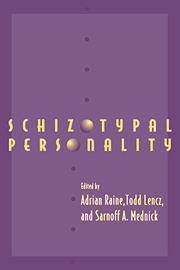Book contents
- Frontmatter
- Contents
- List of contributors
- Preface
- Acknowledgments
- Part I Introduction
- Part II Genetics and neurodevelopment
- Part III Assessment
- Part IV Categorical versus dimensional approaches
- Part V Psychophysiology and psychopharmacology
- Part VI Neuropsychology
- Part VII Brain imaging
- 16 Brain morphology in schizotypal personality as assessed by magnetic resonance imaging
- 17 The potential of physiological neuroimaging for the study of schizotypy: experiences from applications to schizophrenia
- Part VIII Conclusion
- Part IX Appendix
- Name Index
- Subject Index
16 - Brain morphology in schizotypal personality as assessed by magnetic resonance imaging
from Part VII - Brain imaging
Published online by Cambridge University Press: 04 August 2010
- Frontmatter
- Contents
- List of contributors
- Preface
- Acknowledgments
- Part I Introduction
- Part II Genetics and neurodevelopment
- Part III Assessment
- Part IV Categorical versus dimensional approaches
- Part V Psychophysiology and psychopharmacology
- Part VI Neuropsychology
- Part VII Brain imaging
- 16 Brain morphology in schizotypal personality as assessed by magnetic resonance imaging
- 17 The potential of physiological neuroimaging for the study of schizotypy: experiences from applications to schizophrenia
- Part VIII Conclusion
- Part IX Appendix
- Name Index
- Subject Index
Summary
Over the past two decades, there have been literally hundreds of studies published in the psychiatric literature on the topic of brain morphology in schizophrenia as assessed by computerized tomography and magnetic resonance imaging (for good overviews, see Gur & Pearlson, 1993; Pearlson & Marsh, 1993; Shelton & Weinberger, 1986). The majority of these reports have employed the strategy of comparing groups of schizophrenics and normal controls in terms of the size of various aspects of brain anatomy. Significant group differences have been demonstrated for many brain regions, most notably, larger ventricular size among the schizophrenics. A host of other studies have explored the relationship between brain morphology and various clinical, neuropsychological, and other neurobiological measures. Although the meaning and implications of these morphological differences have yet to be fully elucidated, there is an emerging sense of confidence within the research community that these neuroimaging findings will provide important clues to the understanding of the etiological and pathophysiological mechanisms underlying schizophrenia.
The primary question that is addressed in this chapter involves the extent to which studies of brain morphology may also serve to provide clues in terms of understanding schizotypal personality. As is evident from this volume, the construct of schizotypy itself remains controversial. Is the distinction between schizotypy and schizophrenia valid? That is, is it really distinct from schizophrenia in terms of its underlying pathophysiology and etiology? Is it merely a milder variant of schizophrenia? Does it share a genetic diathesis with schizophrenia but differ in terms of environmental factors? Is it a different disorder entirely?
- Type
- Chapter
- Information
- Schizotypal Personality , pp. 385 - 405Publisher: Cambridge University PressPrint publication year: 1995
- 3
- Cited by



